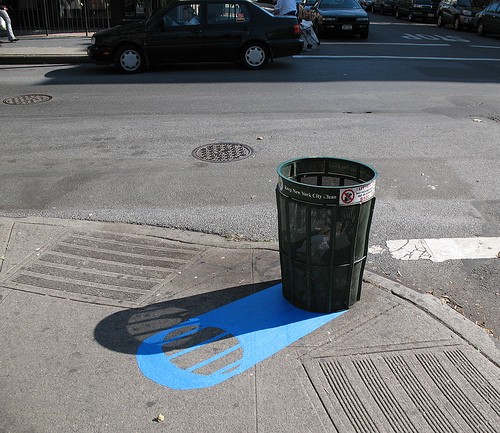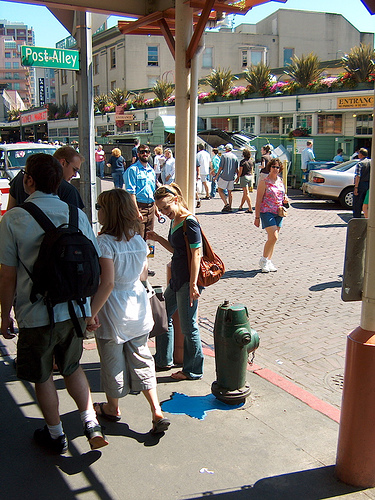Later this month, a project by Joe Penrod called Orange and Blue will be opening at Oakland’s Swarm Gallery along with works by Jared Clark and Jake Watling as part of the ENTER/EXIT exhibition. I’m not especially tuned into Oakland’s thriving arts community, but I have known Watling for several years (I may have occasion to write more about some of his nice Oakland-inspired work in the future), so I happened to be looking at info about this show in advance. Penrod is based in Olympia, Washington, and much of his work has been devoted to the quixotic pursuit of shadowcatching, using blue painter’s tape and photography. Here is one nice example (images reproduced with the gracious permission of the artist):
I assume that the title requires no explanation. Shadows have long had a somewhat uncertain ontological status, dating back to Plato’s cave allegory, and probably before. There’s no doubt that shadows are real — we can see them with our own eyes, after all — but good luck trying to touch one, or pack it up and take it home with you.
Penrod certainly isn’t the first artist to try to preserve shadows — one might argue that the history of photography has been one long inquiry into the preservation of shadows — but I love the playfulness of the bright blue tape, and the whimsy involved in trying to finish the taping and photographing before the shadow has moved. The movement of the shadows enables some of my favorite pieces, like this one on a Williamsburg street corner:
Sometimes, too, it’s not the shadow that moves. These images are great fun (trying to catch shadows could be an amusing game for small children), but then you realize that most of these tape outlines will hardly outlast the shadows they are capturing, whether because they will be worn away, or deteriorate in the weather, or be removed by diligent city workers. Thus the need to photograph the outlines after they are complete. Is the blue tape outline the artwork, or is the photograph of the outline the work of art?
Both, surely, but how long will a digital photograph last? Forever, we hope, but in the grand scheme of things, those digital files may be as fleeting as the blue tape, which is as fleeting as the shadows themselves.
I was particularly interested in these works because my friend Pablo Manga, an artist here in Oakland, also works with tape, but with dramatically different results. You might think that tape would be a limiting medium, but Pablo’s works achieve very different effects depending on the kind of tape and the colors he chooses. Even variations in the manufacturing quality of the tape can create some fascinating effects. And that’s all before any decisions about how to place the tape, which produce an entirely different set of possibilities.
I don’t want to deprive Penrod’s work of its charm by spewing a lot of commentary about it, so I will spare my readers any additional thoughts. The best response to art like this, in my opinion, is summed up by this woman at Pike’s Place in Seattle:
If you can make at least one person stop, smile, and point, then that’s an artistic success as far as I’m concerned. The Swarm Gallery exhibition, at 560 2nd Street near Jack London Square, will last from February 20th to March 29th. Among the many objects whose shadows Penrod has tried to snare are orange traffic cones, and his Swarm installation will involve traffic cones as well. You can also find more work on Penrod’s blog or his Flickr portfolio (there’s more than just the tape outlines, even though that’s all I’ve mentioned here.) Good stuff, I think, and I definitely plan to check it out in person when the show opens.




8 Comments